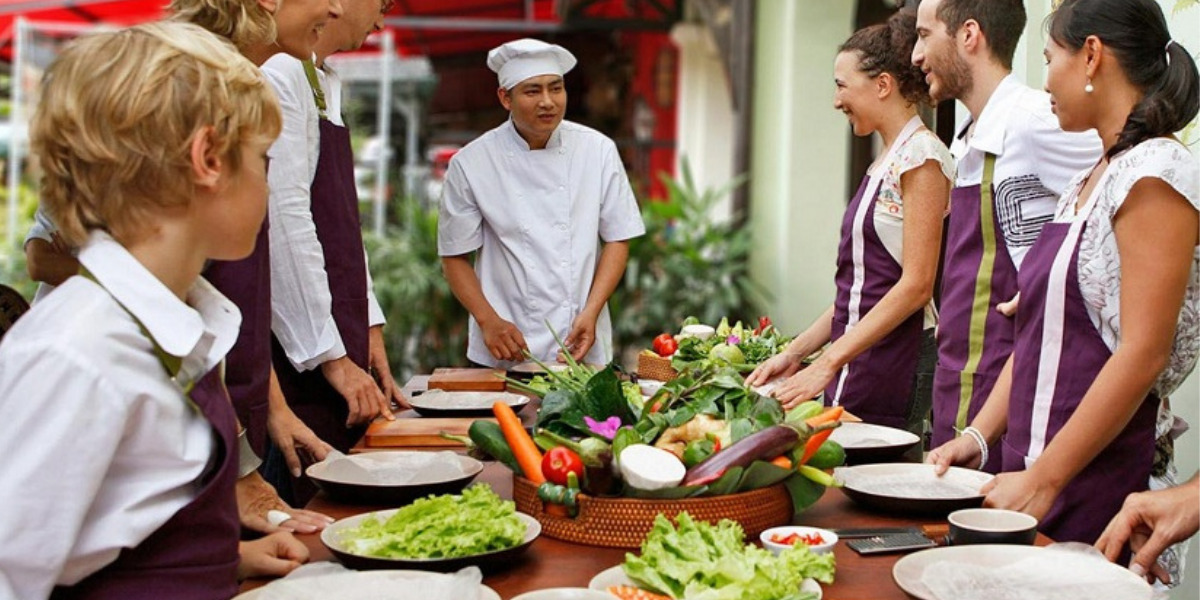Research indicated that Vietnamese traditional music or Vietnamese folk music was born very early because since ancient times, the people have always considered music an indispensable part of life, appearing everywhere from festivals, weddings, and funerals, to the stage and theater. Because of the extreme diversity between not only in regions but also in ethnic groups, the following article will only review the top types of traditional music of Vietnam.
1 - Vietnamese traditional music: Hue royal court music
As the name suggests, Hue royal court music (Nhã Nhạc Cung Đình Huế) is the music of the feudal court of Vietnam, performed on festive occasions of the year and on important days such as the coronation, death of the Kings, Lunar New Year… According to historical records, Hue royal court music has a process of formation and development through many dynasties, from the Ly (1010 - 1225) to the Nguyen (1802 - 1945), when it reached its peak after many stages. This type of traditional music of Vietnam was recognized by UNESCO as a Masterpiece of the Oral and Intangible Heritage of Humanity in December 2003.
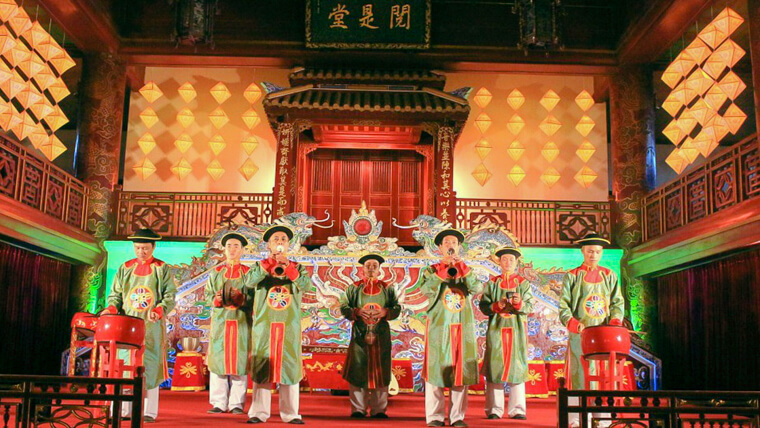
Source: dantri
This Vietnamese traditional music has elegant lyrics and noble performance, contributing to the solemnity of ceremonies, and is a symbol of the power, longevity and prosperity of the dynasty. Hue royal court music now exists in the form of an orchestra that is performed on many special occasions such as the Hue Festival, Buddhist festivals, diplomatic rites, and Lunar New Year,… Coming to Hue, you shouldn't miss the chance to enjoy royal court music on a dragon boat wandering around the Perfume River.
2 - Vietnam traditional music: Cheo
Cheo (Chèo) is a Vietnamese traditional music originating from the countryside since the 10th century, thriving in the North, especially in the Red River Delta. Starting out from phonological parodies, over time, the Vietnamese developed the short stories based on these parodies into longer, full-length stage plays. The main musical instruments of Cheo are the drum, the erhu and the muo, which are all part of the ancient culture of Vietnam.
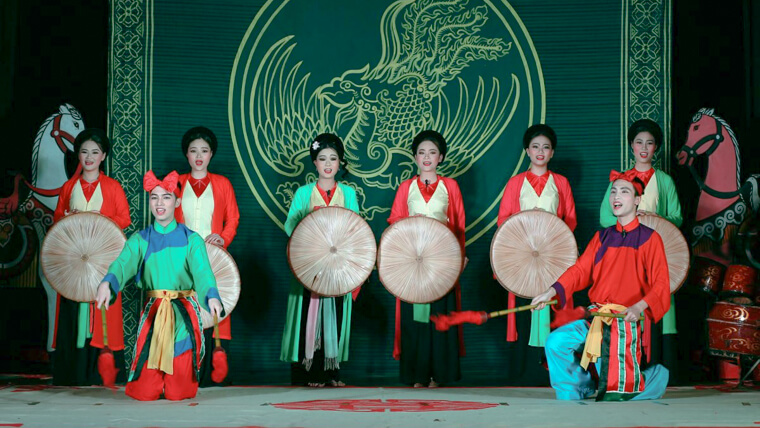
Source: hahatcheovietnam.vn
Cheo is popular with the public and is considered a form of storytelling and public interacting via the stage, being able to perform impromptu using multi-vocal, multi-meaningful language combined with similes. This genre of Vietnamese traditional music consists of various literary genres such as lyrical, romantic or epic, reflecting all aspects of the national identity, personal feelings and common concerns of mankind such as love, friendship and affection.
Festivals in the Red River Delta often have cheo performances in the form of stages, screenings or contests and festivals such as Hoa Lu festival (Ninh Binh Province), Con Son Kiep Bac festival (Hai Duong Province), Keo pagoda festival (Thai Binh Province), etc. If you want to learn more about this type of traditional music in Vietnam, you can watch some famous plays such as Quan Am Thi Kinh, Luu Binh - Duong Le, Tong Tran - Cuc Hoa,…
3 - Vietnamese traditional music: Xam
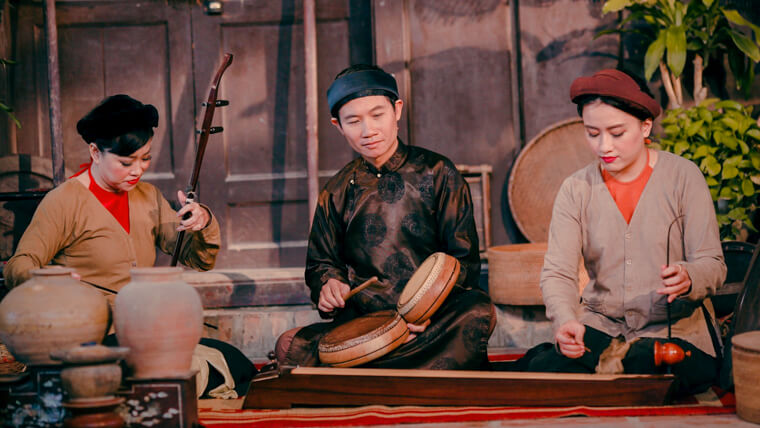
Source: hanoimoi.com
Believed to have originated around the 14th century, Xam (Xẩm) is the famous traditional folk music of Vietnam in the North, commonly known today as street troupes, mistaken for the singing of only the blind and beggars. In fact, Xam singing is a professional folk music genre with a stage everywhere, and people with unfortunate lives have used it as a means of making a living. From the past half century, due to many reasons, Xam singing has gradually disappeared, losing its unique artistic values, prompting the government to protect and preserve this type of folk music of Vietnam.
It can be said that this genre of Vietnamese traditional music is the spiritual voice of the working masses, containing an inner world with people's thoughts and feelings for their homeland, country, parents, etc. Xam songs often have the spirit of patriotism, referring to many problems in all aspects of life, condemning injustices of power, oppression, and defending the unfortunates. Xam singers also regularly update topical issues and criticize the bad habits of contemporary society in their singing.
4 - Quan Ho folk songs (Dân Ca Quan Họ)
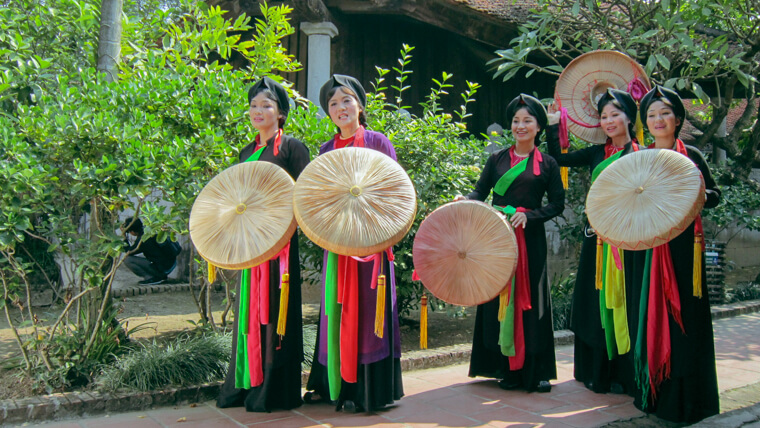
Source: bvhttdl.gov.vn
This is one of the typical genres of Vietnamese traditional music, in the Red River Delta and especially around the two provinces of Bac Ninh and Bac Giang. However, up to now, there has been no research to officially prove the birth time of Quan Ho folk song, some said 11th century, while others believed it’s 17th century, and more.
Quan Ho folk song traditionally is a form of love singing of brothers and sisters in traditional costumes, without music and had to follow strict rules, so it was seen as more of a fun game than a performance. Today, this Vietnamese traditional music has a richer form of performance, including solo, duo, singing with accompaniment dance, using music and different arrangements. Becoming an intangible cultural heritage recognized by UNESCO on September 30, 2009, Quan Ho folk song can often be seen performing in Bac Ninh Province, especially on festive occasions.
5 - Vietnamese traditional music: Chau Van
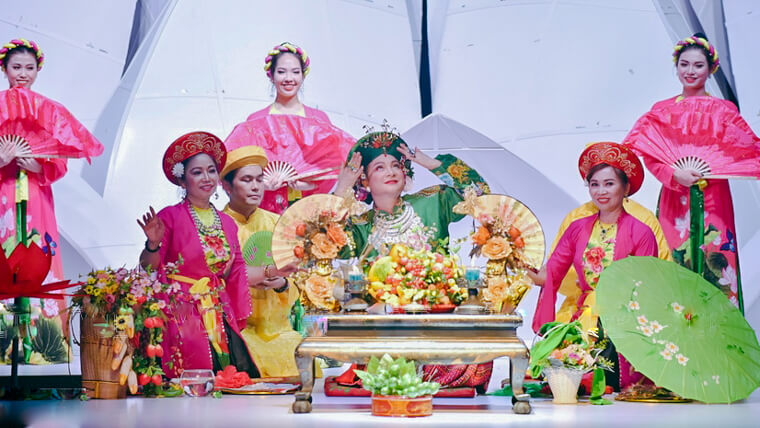
Chau Van is a famous type of Vietnamese folk music - Source: vietnam.vnanet.vn
Chau Van (Chầu Văn) also originated in the Northern Delta region, associated with the rituals of the Four palaces (worshiping the Mother Goddess) and the worship of the Holy Tran (Holy King Tran Hung Dao). Chau Van singing is said to have existed since the 13th century and was most flourishing in the late 19th - early 20th centuries, when there were often competitions to choose who could sing. However, from 1954 onward, the state carried out social reforms to eliminate superstitions after the country’s peace was restored, so Chau Van singing gradually disappeared, and only got revived after 1986.
This traditional music in Vietnam has many forms of performance including worship singing, serve singing (singing for the mediums), and singing at the temple or communal houses. Singing Chau Van is considered the most popular in Hue, also sung to serve people visiting temples and pagodas, existing for a long time in folk from the North to the Central region, to the mountainous provinces of Lang Son, Quang Binh...
6 - Vietnamese traditional music: Ca Tru
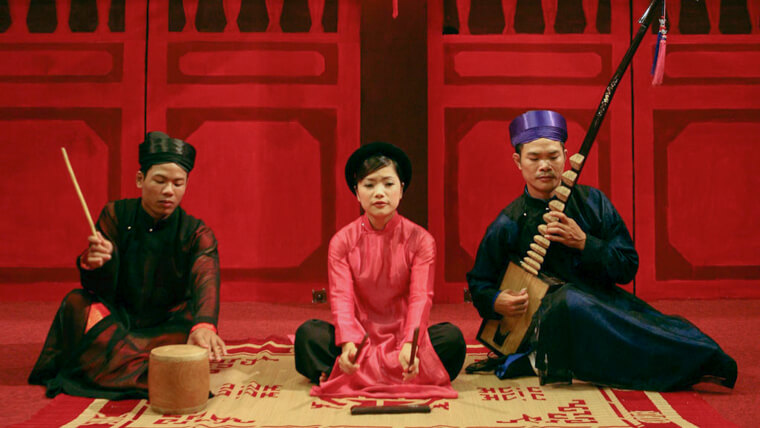
Source: vethamquan.vn
As a traditional art in the north of Vietnam, it is not known when Ca Tru (Ca Trù) started but has been in vogue since the 15th century, used to be a type of royal song and was loved by aristocrats and scholars. It combines singing with a number of ethnic musical instruments, both vocal and instrumental, expressing a delicate and sophisticated musical language.
Ca Tru is a form of traditional music of Vietnam that uses many literary genres in performance, with the most common being singing and telling. A performance should have three main components, including a female singer (“dao” or “female singer”), a male musician (“kep”) and the spectator (“mandarin”, often the song's author). The performance space of this Vietnamese traditional music has a relatively small scope with the “dao” sitting on a mat in the middle, while the “kep” and “mandarin” sitting on the sides.
On October 1, 2009, Ca Tru was recognized as an intangible heritage in need of urgent protection by UNESCO. Nowadays, you can watch ca tru performances at clubs in many northern provinces and cities, and especially at the non-annual national Ca Tru festival organized by the Ministry of Culture, Sports and Tourism.
7 - Vietnamese traditional music: Tuong
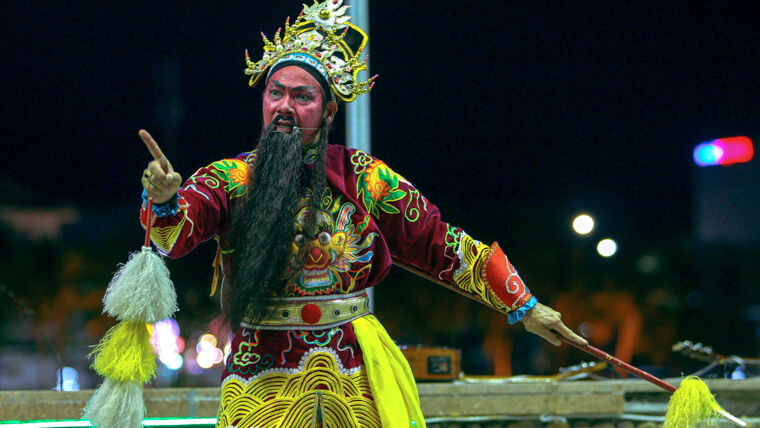
Source: Vnexpress
According to many scholars, Tuong (Tuồng) comes from the Vietnamese folk dance and music, and in the process of development has been influenced by Cham music and Chinese Opera way of disguise,… Although it is not known when it was born, this type of traditional Vietnamese music has undergone at least 7 centuries of formation, reaching its most brilliant peak in the 19th century. At that time, the kings of the Nguyen Dynasty loved it very much, giving many incentives and opening schools to train Tuong artists, hiring people to write scripts that still exist today.
The acting style of this Vietnamese traditional music is heavy on conventions and formalities, amplifying the acting in real life so that the audience can easily feel the emotions, using a really loud, high and clear voice. Depending on the historical period, this genre of Vietnamese country music has many different themes, but often shows the images of the role models who sacrificed themselves for the great cause, and the lessons about good human behavior. In Vietnam, there are currently 7 traditional Tuong theater art units distributed in all three regions, including the Vietnam Tuong Theater at No.51A Duong Thanh Street, Cua Dong Ward, Hoan Kiem District, Hanoi.
8 - Vietnamese traditional music: Ho
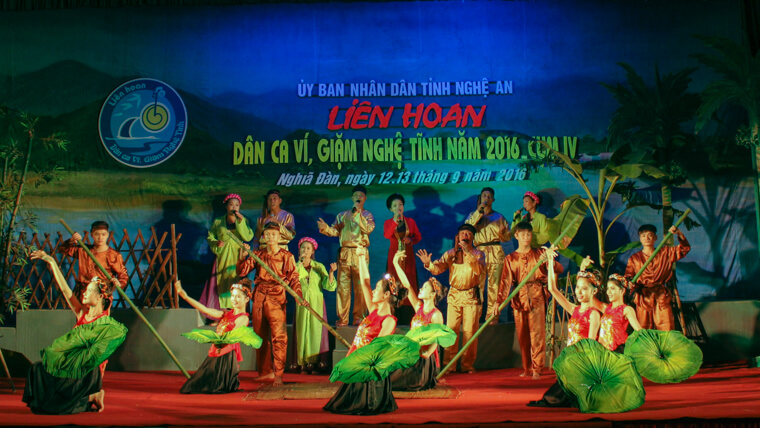
Source: toquoc.vn
Ho (Chanty) is a type of traditional music in Vietnam, which is a cultural feature of the central and southern regions, originating from river labor, expressing the emotions and feelings of the workers. Ho singing was originally a response between boys and girls while riding boats on the river, but then the working people sang it everywhere and every time: doing business, working in the fields, rowing boats … The emotions conveyed in each song are also very diverse, with familiar lyrics and content, including the use of proverbs.
This type of Vietnamese traditional music is a popular folk singing art form in many regions, forming distinct types of Ho associated with the life characteristics of that region. Some popular types of singing are: Ho Dong Thap, Ho pulling the net, ... and Vi Giam folk song, which was recognized by UNESCO as a representative intangible cultural heritage of humanity on November 27, 2014.
9 - Hue Singing (Ca Huế)
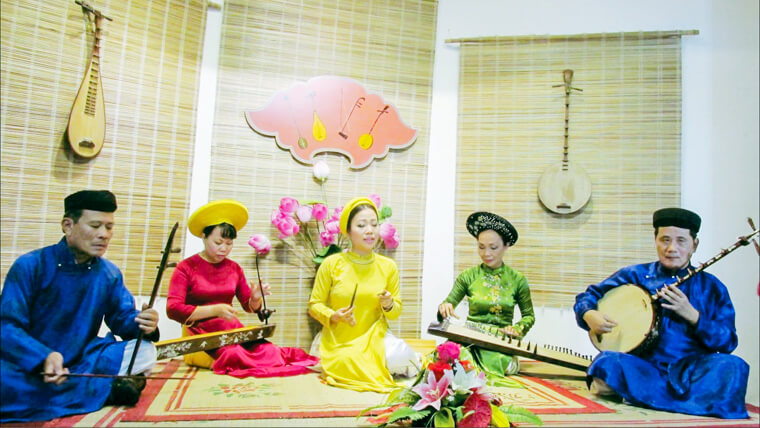
Source: khamphahue.com.vn
As a genre of traditional music of Hue originating around the 17th century, Hue Singing is quite similar in many ways to Tru Singing, a mixture of idyllic folk music and royal court music. This type of Vietnamese traditional music has high value in art, as well as education about aesthetic ideas, emotions and human personality. It used to play the role of national music, an elegant hobby of the royal princes and mandarins, and was widely used in the Northern and Southern provinces. Coming to Hue, you must definitely experience sitting on a boat on the poetic Perfume River and immerse yourself into the profound Hue songs, mixed with the melodious sound of the orchestra full of Vietnamese traditional instruments of Bau, Tranh, Lute, Flute…
This traditional music of Vietnam was recognized as a National Intangible Cultural Heritage in 2015 and a dossier is currently being prepared to submit to UNESCO for recognition as a Representative Intangible Cultural Heritage of Humanity.
10 - Vietnamese traditional music: Don Ca Tai Tu
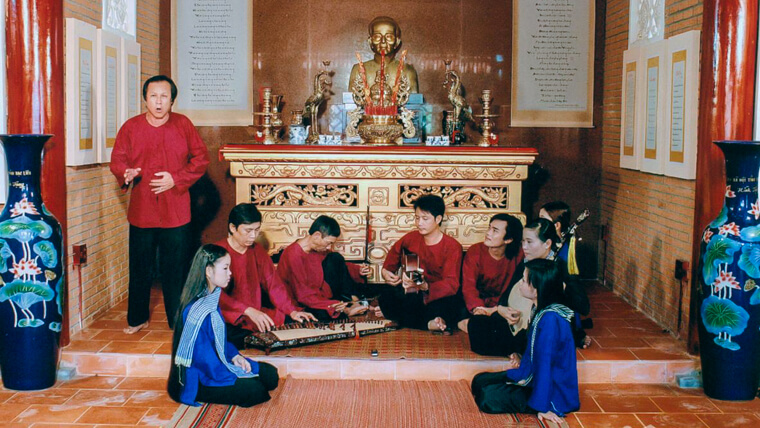
Source: danvan.vn
Don Ca Tai Tu (Đờn Ca Tài Tử or Amateur music) was formed and developed at the end of the 19th century, originating from ceremonial music, Hue royal court music and folklore. Don Ca Tai Tu combines the use of musical instruments and singing, performed by ordinary people in southern rural areas after hours of work to share common hobbies. This type of traditional music in Vietnam appears not only at festivals but also during the post-harvest period, played in the shade of trees, on boats or during a moonlit night… The band usually uses 5 musical instruments including Tranh, Ty Ba, Kim, Co, and Tam, often accompanied by a seven-hole flute, and later includes a concave guitar.
The word “amateurs” does not actually mean that they are not experts, but that these people do not use art to earn a living, only for fun or impromptu moments. The art of this traditional music of Vietnam is currently being developed in 21 provinces and cities in the South of Vietnam such as Ca Mau, Dong Nai, Vinh Long ... in which, Bac Lieu, Binh Duong, Tien Giang, and Ho Chi Minh City are those with the most people singing.
In the process of historical development, Vietnamese residents have constantly created many musical instruments and musical genres to express their feelings, to give strength and work spirit. Vietnamese traditional music is imprinted with the historical development of musical language, rich in local and national colors.







 — Giang Phạm
— Giang Phạm



















